Building Information Modelling for Health, Safety and Sustainability
76 Pages14646 Words383 Views
Added on 2022-11-19
About This Document
This thesis explores the concept of BIM and its potential benefits in improving health and safety in the construction industry. It covers various aspects of BIM, including its history, benefits, real-life applications, and case studies. The author also discusses the Irish government's strategy for the increased use of digital technology in the delivery of key public works projects that are funded through the public capital program. The thesis is written by Clare Everett and submitted in fulfillment of the requirements for B.Sc. in Environmental Health and Safety Management.
Building Information Modelling for Health, Safety and Sustainability
Added on 2022-11-19
ShareRelated Documents
Building Information Modelling, for Health, Safety
and Sustainability
A thesis submitted in fulfillment of the Requirements for
B.Sc. in Environmental Health and Safety Management
Author: Clare Everett -A00247834
Supervisor: Dr Sean Reidy, Department of Life and Physical
Science, Athlone Institute of Technology
Summer 2019
1
and Sustainability
A thesis submitted in fulfillment of the Requirements for
B.Sc. in Environmental Health and Safety Management
Author: Clare Everett -A00247834
Supervisor: Dr Sean Reidy, Department of Life and Physical
Science, Athlone Institute of Technology
Summer 2019
1
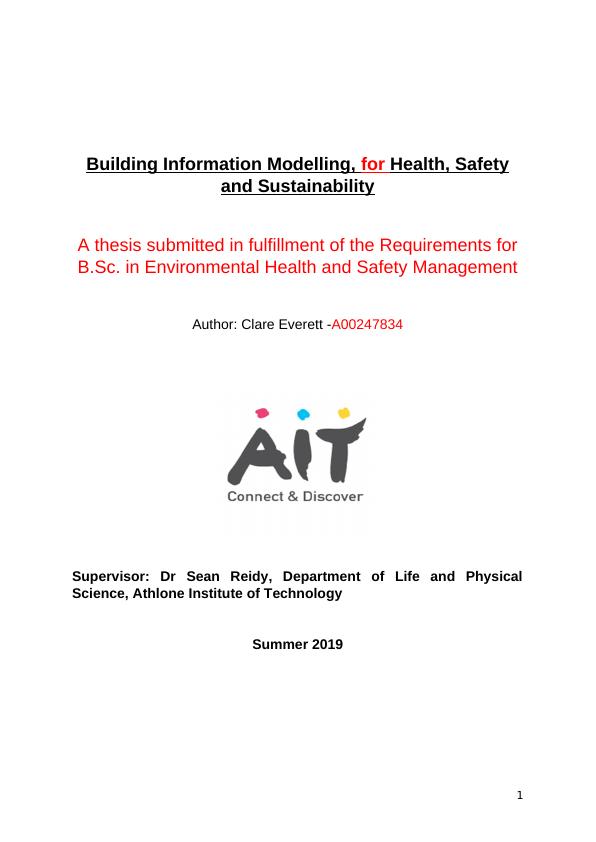
Contents
List of Figures....................................................................................................................... 3
Acknowledgements.............................................................................................................. 4
Abstract................................................................................................................................. 5
Introduction.......................................................................................................................... 6
Chapter 1............................................................................................................................... 7
What is BIM?...................................................................................................................... 7
Building Information Modelling............................................................................................7
Aim........................................................................................................................................ 8
Chapter 2:............................................................................................................................. 3
BIM in the Government strategy......................................................................................3
Chapter 3............................................................................................................................... 6
BIM for Health and Safety................................................................................................6
Chapter 4............................................................................................................................. 12
A Multi-Dimensional Solution........................................................................................12
Chapter 5............................................................................................................................. 16
History of BIM.................................................................................................................16
Chapter 6............................................................................................................................. 17
Benefits of BIM................................................................................................................17
Chapter 7............................................................................................................................. 20
WHY BIM - Making the Case for BIM.............................................................................20
Chapter 8............................................................................................................................. 25
BIM Standards................................................................................................................. 25
Chapter 9:........................................................................................................................... 29
‘Real Life’ applications of BIM.......................................................................................29
Chapter 10:......................................................................................................................... 33
Opportunities for BIM........................................................................................................33
Chapter 11:......................................................................................................................... 38
Case studies..................................................................................................................... 38
Chapter 12:......................................................................................................................... 44
The future of BIM for H&S.................................................................................................44
Chapter 13:.......................................................................................................................... 46
Conclusion...................................................................................................................... 46
Appendices......................................................................................................................... 49
Bibliography....................................................................................................................... 61
References.......................................................................................................................... 63
2
List of Figures....................................................................................................................... 3
Acknowledgements.............................................................................................................. 4
Abstract................................................................................................................................. 5
Introduction.......................................................................................................................... 6
Chapter 1............................................................................................................................... 7
What is BIM?...................................................................................................................... 7
Building Information Modelling............................................................................................7
Aim........................................................................................................................................ 8
Chapter 2:............................................................................................................................. 3
BIM in the Government strategy......................................................................................3
Chapter 3............................................................................................................................... 6
BIM for Health and Safety................................................................................................6
Chapter 4............................................................................................................................. 12
A Multi-Dimensional Solution........................................................................................12
Chapter 5............................................................................................................................. 16
History of BIM.................................................................................................................16
Chapter 6............................................................................................................................. 17
Benefits of BIM................................................................................................................17
Chapter 7............................................................................................................................. 20
WHY BIM - Making the Case for BIM.............................................................................20
Chapter 8............................................................................................................................. 25
BIM Standards................................................................................................................. 25
Chapter 9:........................................................................................................................... 29
‘Real Life’ applications of BIM.......................................................................................29
Chapter 10:......................................................................................................................... 33
Opportunities for BIM........................................................................................................33
Chapter 11:......................................................................................................................... 38
Case studies..................................................................................................................... 38
Chapter 12:......................................................................................................................... 44
The future of BIM for H&S.................................................................................................44
Chapter 13:.......................................................................................................................... 46
Conclusion...................................................................................................................... 46
Appendices......................................................................................................................... 49
Bibliography....................................................................................................................... 61
References.......................................................................................................................... 63
2
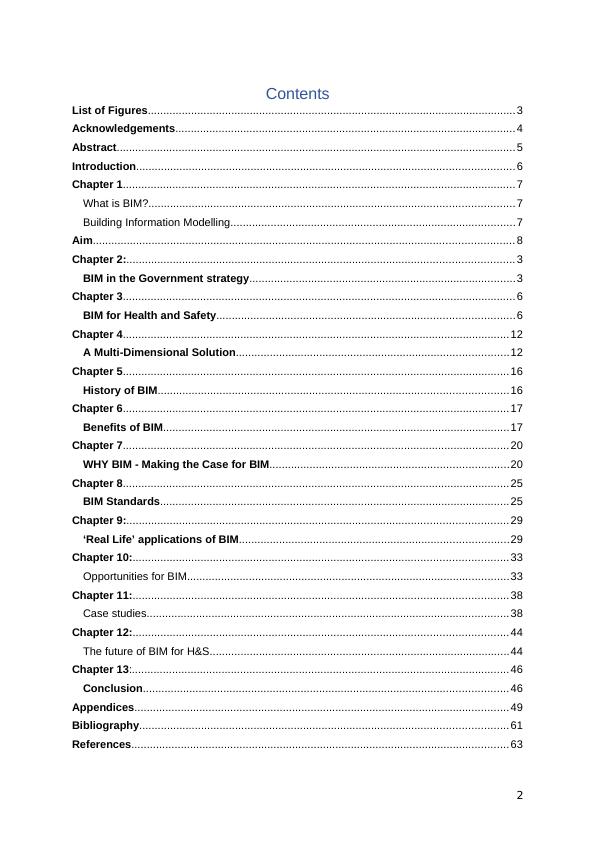
List of Figures
Figure 2.1: National BIM council Roadmap..................................................................5
Figure 3.1- Workplace accidents figures 2012.............................................................9
Figure 3.2: Annual report and Summary stats 2014..................................................10
Figure 4.1-( Audodesk2019)BIM dimensions — 3D (object model), 4D (time), 5D
(cost), 6D (operation), 7D (sustainability), and even 8D (Safety)...............................13
Figure 5.1-life cycle of technology in construction industry (Autodesk 2019)............17
Image 5.2- How things used to be done (Construction Industry, 2019).....................18
Figure 5.3- Benefits of BIM (building information modelling) (BluEnt, 2019).............16
Fig 6.1 – BIM forecasted Improvements (Construction Magazine, January 2019)....19
Figure 9.1 Tracking and Sensing My zone workers alert system(desiningbuildings,
2019)...........................................................................................................................31
Figure 9.2 Simulation and Virtual Reality (desiningbuildings,2 019)..........................32
Fig 11.1 4D model of London Victoria (squarespace, 2019)......................................41
3
Figure 2.1: National BIM council Roadmap..................................................................5
Figure 3.1- Workplace accidents figures 2012.............................................................9
Figure 3.2: Annual report and Summary stats 2014..................................................10
Figure 4.1-( Audodesk2019)BIM dimensions — 3D (object model), 4D (time), 5D
(cost), 6D (operation), 7D (sustainability), and even 8D (Safety)...............................13
Figure 5.1-life cycle of technology in construction industry (Autodesk 2019)............17
Image 5.2- How things used to be done (Construction Industry, 2019).....................18
Figure 5.3- Benefits of BIM (building information modelling) (BluEnt, 2019).............16
Fig 6.1 – BIM forecasted Improvements (Construction Magazine, January 2019)....19
Figure 9.1 Tracking and Sensing My zone workers alert system(desiningbuildings,
2019)...........................................................................................................................31
Figure 9.2 Simulation and Virtual Reality (desiningbuildings,2 019)..........................32
Fig 11.1 4D model of London Victoria (squarespace, 2019)......................................41
3
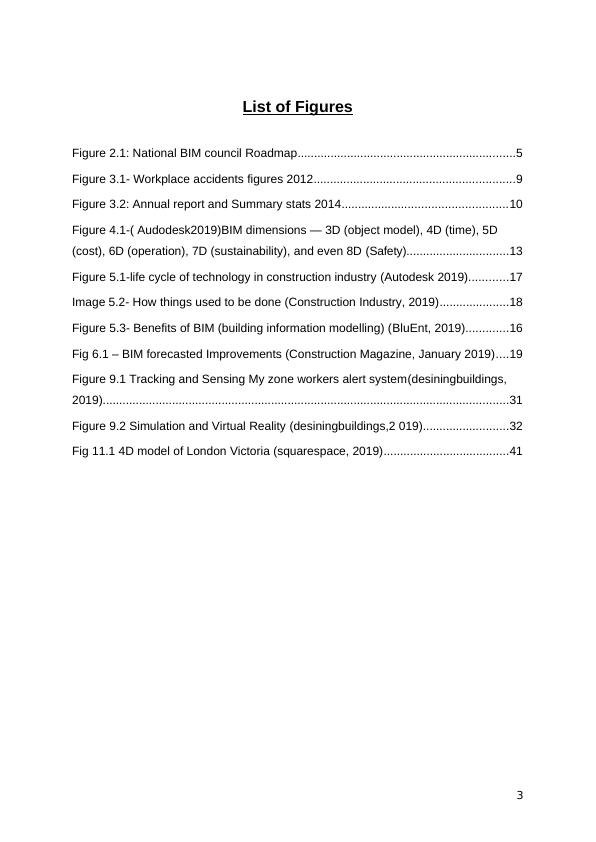
Acknowledgements
Throughout this project many people have helped me in so many ways and have
given me their time and experience and I am very grateful for this. And without the
support from my family and friends I would not have been able to complete this
project.
I would also like to take this opportunity to thank Dr Sean Reidy for his time and
patience and all his help in doing this project.
4
Throughout this project many people have helped me in so many ways and have
given me their time and experience and I am very grateful for this. And without the
support from my family and friends I would not have been able to complete this
project.
I would also like to take this opportunity to thank Dr Sean Reidy for his time and
patience and all his help in doing this project.
4

Abstract
This thesis will look at the newest construction technology BIM (building information
modelling) its basic principles and how this technology can gather and interpret
information. Information that can be passed onto others. The potential benefits in
improving health and safety, by reducing accidents and deaths.
This thesis will look at how these benefits are brought about. The author hopes to
explain complex health and safety and the improving benefits of BIM (Building
information modelling) by improving communications and enhancing standards. This
model will in turn become a basis for a zero-harm culture.
We will look at Case studies from separate scenarios and see the challenges they
face, in relation to people, culture, and processes. Like bringing a whole team
together to optimize on certain activities at all stages of the life cycle of a project for
safer logistics and any future maintenance problems.
5
This thesis will look at the newest construction technology BIM (building information
modelling) its basic principles and how this technology can gather and interpret
information. Information that can be passed onto others. The potential benefits in
improving health and safety, by reducing accidents and deaths.
This thesis will look at how these benefits are brought about. The author hopes to
explain complex health and safety and the improving benefits of BIM (Building
information modelling) by improving communications and enhancing standards. This
model will in turn become a basis for a zero-harm culture.
We will look at Case studies from separate scenarios and see the challenges they
face, in relation to people, culture, and processes. Like bringing a whole team
together to optimize on certain activities at all stages of the life cycle of a project for
safer logistics and any future maintenance problems.
5

Introduction
This Project will focus on BIM (Building information modelling) and how the digital
transition, happening within the construction industry is positively contributing to
increase construction sustainability and safety management. Through Research for
this project, it has been shown that the construction industry is full of potential injury
both to humans and to the environment. Maybe this new approach may be needed
to reduce this injury.
This report focuses on BIM (Building information modelling) and how it can facilitate
earlier collaboration between architects, engineers and constructors and this early
intervention can identify potential hazards within the design phase and plan to
eliminate risk before construction begins.BIM can open many new ways to integrate
construction processes and health and safety issues.
This project covers various aspects of BIM from sustainability, health and safety tips
and opinions on the best use of this new and exciting Technology. This project will
look at how the Irish Government has said it will require BIM Level 2 on complex
projects from 2019, with medium and simple projects being phased in over the
coming years, how to become certified and the benefits it can bring to a small business
and even on a larger scale.
During this project the author met with the ACB group Managing Director and got
firsthand information on the process of becoming certified and the benefits they are
experiencing from being BIM level 2 certified. The author will also look at through desk
top research larger more complex projects and see how BIM help to improve the
Construction and the after care process.
Although BIM is eciting and hold huge potential to the reduction of accident in the
construction industry , it is new and not all people like change and can be reluctant to
6
This Project will focus on BIM (Building information modelling) and how the digital
transition, happening within the construction industry is positively contributing to
increase construction sustainability and safety management. Through Research for
this project, it has been shown that the construction industry is full of potential injury
both to humans and to the environment. Maybe this new approach may be needed
to reduce this injury.
This report focuses on BIM (Building information modelling) and how it can facilitate
earlier collaboration between architects, engineers and constructors and this early
intervention can identify potential hazards within the design phase and plan to
eliminate risk before construction begins.BIM can open many new ways to integrate
construction processes and health and safety issues.
This project covers various aspects of BIM from sustainability, health and safety tips
and opinions on the best use of this new and exciting Technology. This project will
look at how the Irish Government has said it will require BIM Level 2 on complex
projects from 2019, with medium and simple projects being phased in over the
coming years, how to become certified and the benefits it can bring to a small business
and even on a larger scale.
During this project the author met with the ACB group Managing Director and got
firsthand information on the process of becoming certified and the benefits they are
experiencing from being BIM level 2 certified. The author will also look at through desk
top research larger more complex projects and see how BIM help to improve the
Construction and the after care process.
Although BIM is eciting and hold huge potential to the reduction of accident in the
construction industry , it is new and not all people like change and can be reluctant to
6
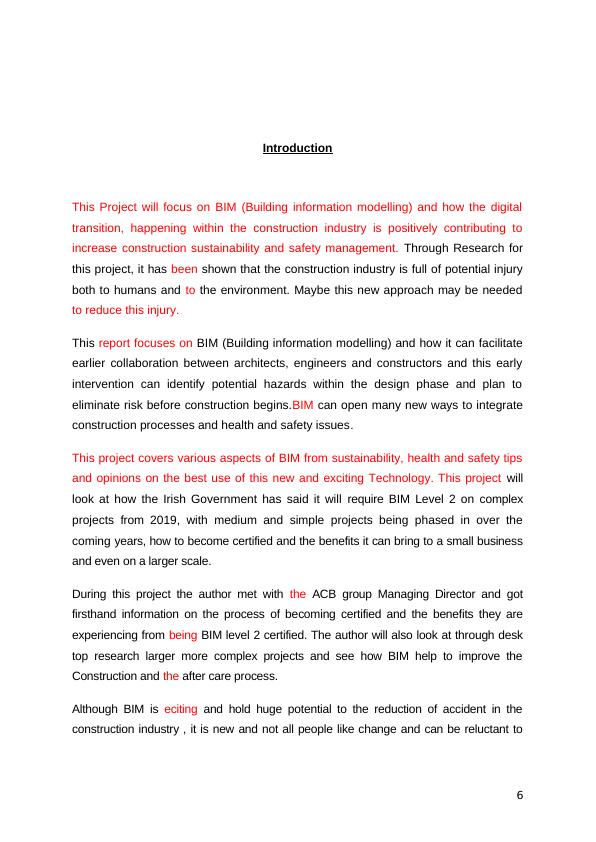
change old habits , but it is good to see the Irish Government is behind this and one
way or another the construction industry will have to follow.
Chapter 1
What is BIM?
Building Information Modelling
7
way or another the construction industry will have to follow.
Chapter 1
What is BIM?
Building Information Modelling
7
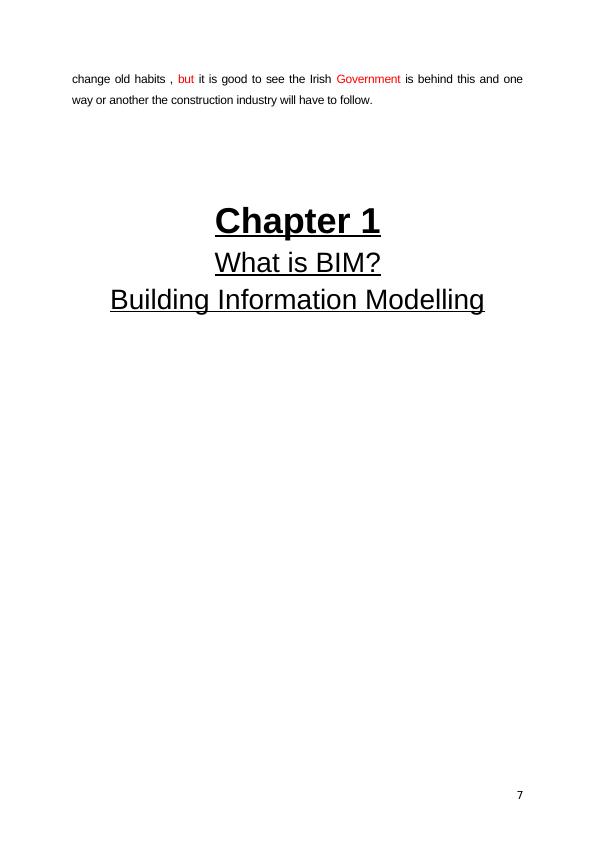
Aim
The aim of this project was to introduce the concept of BIM to a construction industry
employee, and a potential health and safety advisor viewpoint.
The author will explore the idea that BIM is about the combination of processes,
people and most important information – the link between all these separate parties
with the sharing of data between a project team.
This project will look at how BIM is of the utmost importance to the H SA (Health and
safety authority), which can review shared and specifically structured information, to
highlight the nature of accident and best possible ways of avoiding these accidents
before they happen.
This project will cover the following:
What is BIM? Building Information Modelling
BIM in the Government strategy
BIM for Health and Safety
A Multi-Dimensional Solution
History of BIM
Benefits of BIM
Why BIM- making a case for BIM
BIM standards
Real life applications of BIM
Case studies
BIM (Building information modelling) is not a software package instead it is an
approach, which will require several people from separate back grounds to work
together to process and share information- with the use of software.
For BIM to be beneficial the process relies on three main activities:
The generation of the information
Maintaining the information
Effectively using the information
Through and life cycle of any project information is checked and used in many of the
key stages:
Firstly, a client proposal is generated
Design stage, this design is checked against the initial proposal before been
developed.
8
The aim of this project was to introduce the concept of BIM to a construction industry
employee, and a potential health and safety advisor viewpoint.
The author will explore the idea that BIM is about the combination of processes,
people and most important information – the link between all these separate parties
with the sharing of data between a project team.
This project will look at how BIM is of the utmost importance to the H SA (Health and
safety authority), which can review shared and specifically structured information, to
highlight the nature of accident and best possible ways of avoiding these accidents
before they happen.
This project will cover the following:
What is BIM? Building Information Modelling
BIM in the Government strategy
BIM for Health and Safety
A Multi-Dimensional Solution
History of BIM
Benefits of BIM
Why BIM- making a case for BIM
BIM standards
Real life applications of BIM
Case studies
BIM (Building information modelling) is not a software package instead it is an
approach, which will require several people from separate back grounds to work
together to process and share information- with the use of software.
For BIM to be beneficial the process relies on three main activities:
The generation of the information
Maintaining the information
Effectively using the information
Through and life cycle of any project information is checked and used in many of the
key stages:
Firstly, a client proposal is generated
Design stage, this design is checked against the initial proposal before been
developed.
8

End of preview
Want to access all the pages? Upload your documents or become a member.
Related Documents
Bim and Artificial Intelligence in Civil Engineering Assignmentlg...
|43
|13270
|299
Building Information Modelling (BIM) Assignmentlg...
|40
|7435
|497
Use of Technology in Project Life Cycle Management: UAE Construction Industry Perspectivelg...
|23
|8859
|93
